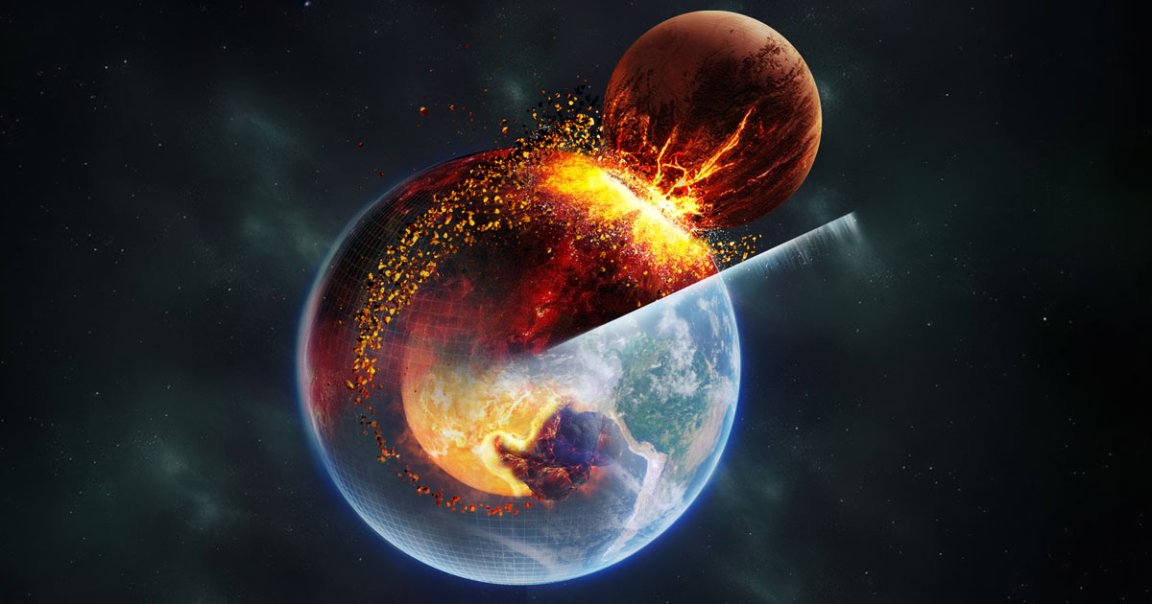
Researchers have long suspected that the Moon was formed after a Mars-sized protoplanet, dubbed Theia, smashed into the primordial Earth some 4.5 billion years ago.
The literally Earth-shattering event sheared off huge amounts of debris, eventually forming our planet’s lonely satellite.
Or at least how the theory goes; not all researchers agree, naturally. Now, though, a team of scientists at the China Academy of Sciences claims to have uncovered new evidence supporting the theory that bigger chunks of Theia than previously thought may have become lodged deep inside the Earth — leaving, perhaps, actual physical evidence of the ancient catastrophe.
The team analyzed two massive blobs of matter, known as large low-velocity provinces (LLVPs), which are buried deep below the African continent and the Pacific Ocean. As detailed in a new paper published in the journal Nature, they ran complex fluid dynamics simulations to figure out the possible origin of these blobs.
By simulating a massive Theia-like object smashing into the Earth, the team found that the upper half of the Earth’s mantle would’ve been melted in the process, allowing roughly ten percent of the object to eventually make its way deep into the Earth, near its core.
These blobs would then be churned around and grow due to convection currents, forming the two LLVPs.
Previous simulations concluded that only traces of Theia had long ago melted into the Earth. The new study, however, suggests that a lot more of the Mars-sized protoplanet ended up trapped inside our planet, around ten percent, accounting for roughly two to three percent of Earth’s overall mass.
Fortunately, that also means we could have a relatively simple way to test this new theory.
“In most of the Moon-forming impact simulations, most of the lunar materials come from the impactor, so we expect future missions can get lunar mantle rocks and compare that with the mantle blobs to see if they share the same chemical signatures,” lead author Qian Yuan, a geophysicist at Caltech, told ScienceAlert.
“If the lunar mantle rock and LLVP-related basalts share the same chemical signatures, they should both originate from Theia,” Yuan told The Guardian.
Plenty of questions remain, and not all the researchers’ peers are entirely on board with the ‘ conclusion that the two LLVPs are primarily leftovers from a collision 4.5 billion years ago.
Planetary scientist Robin Canup of the Southwest Research Institute in Boulder, Colorado, who was not involved in the study, called the scientists’ findings “exciting and provocative,” in an interview with National Geographic.
However, Canup also pointed out that it remains a mystery as to how the purported chunks of Theia avoided “being mixed and homogenized into the Earth’s mantle over the next four and a half billion years.”
“I don’t think the impactor material would be completely mixed, but the amount of mixing that has occurred is underestimated in this study,” geodynamicist Maxim Ballmer of University College London, who was also not involved, told NatGeo.
Competing theories point out that the magma swirling in the lower layer of the Earth’s mantle had plenty of time to form into blobs of differing densities on their own.
At the end of the day, it’s hard to peer so far back into our planet’s prehistory. Drilling to the center of our planet simply isn’t feasible, and whether what we’ll end up finding on the surface of the Moon will support Yuan and his colleague’s tantalizing theory remains to be seen.
But it’s fascinating to watch the process unfold, and we’ll be paying attention.
More on the Earth’s core: There Appears to Be a Slow Leak in Earth’s Core, Scientists Say